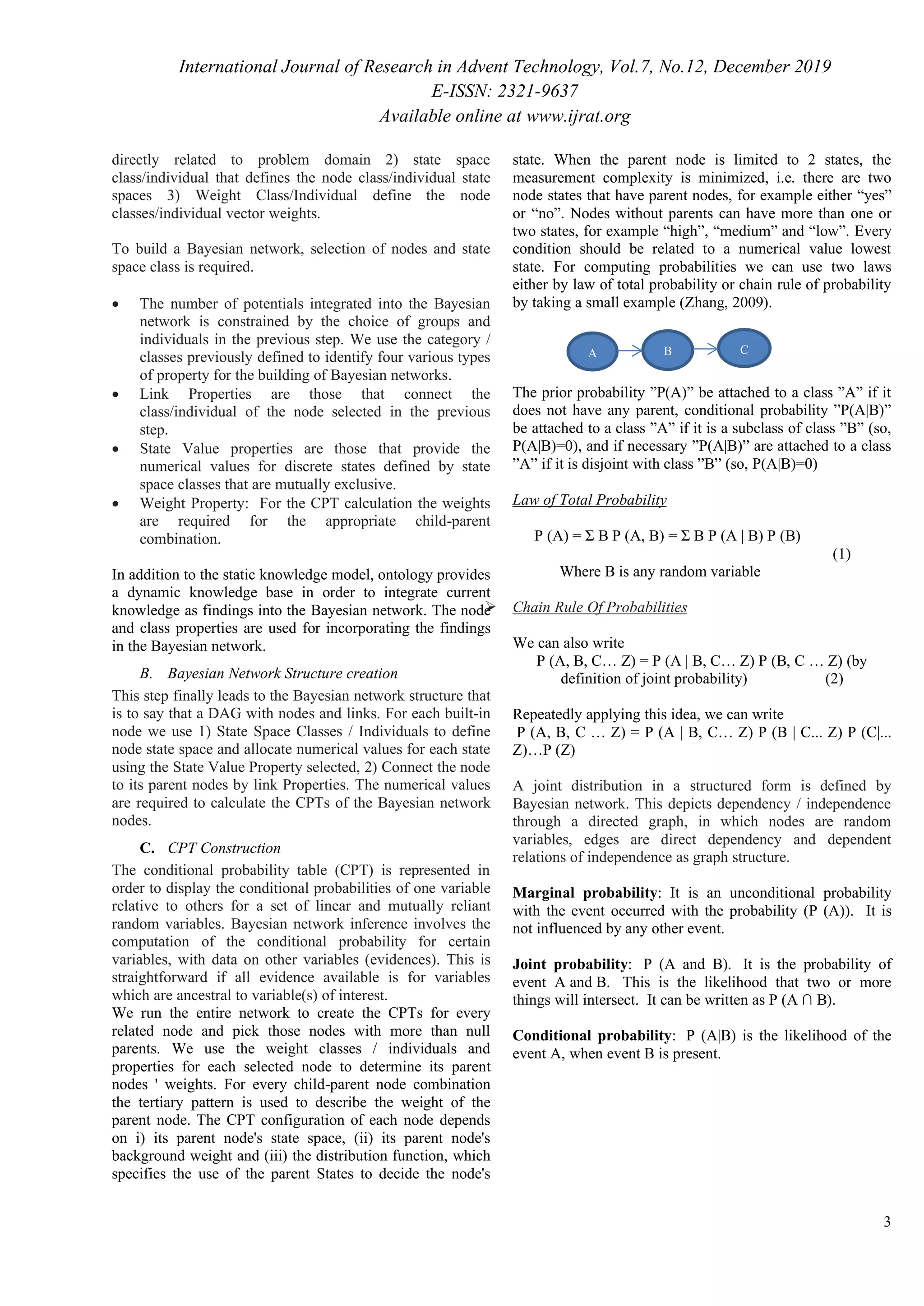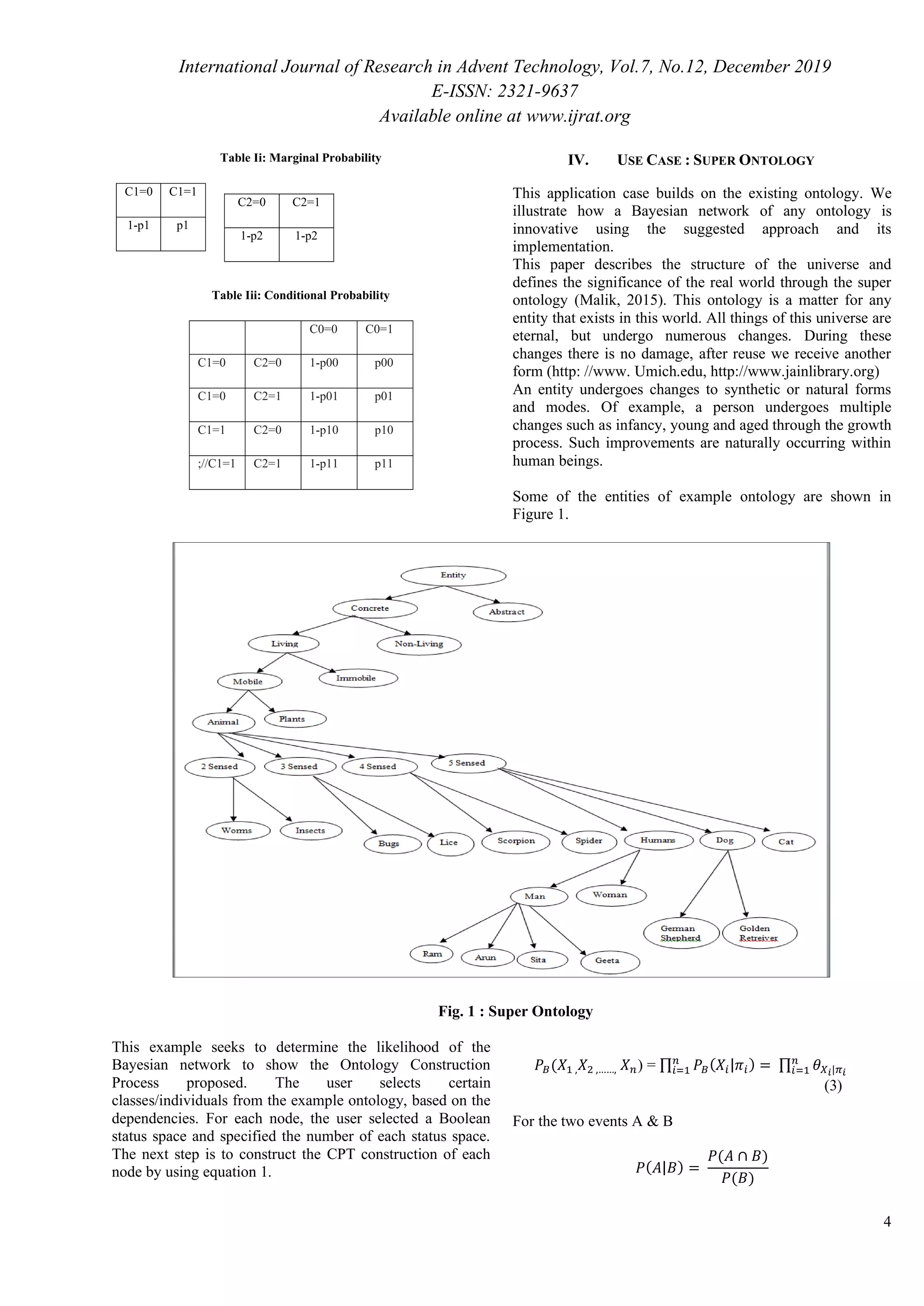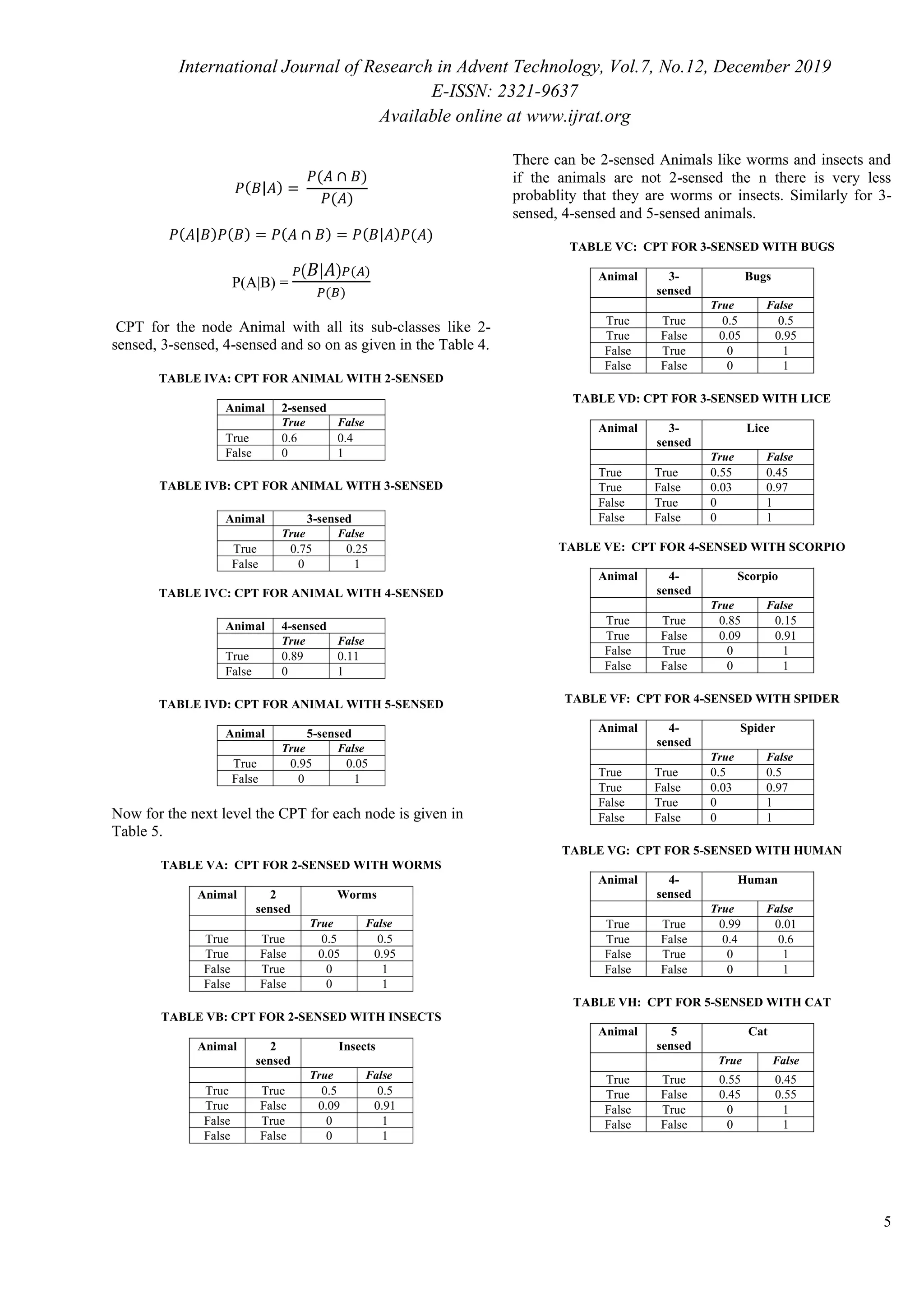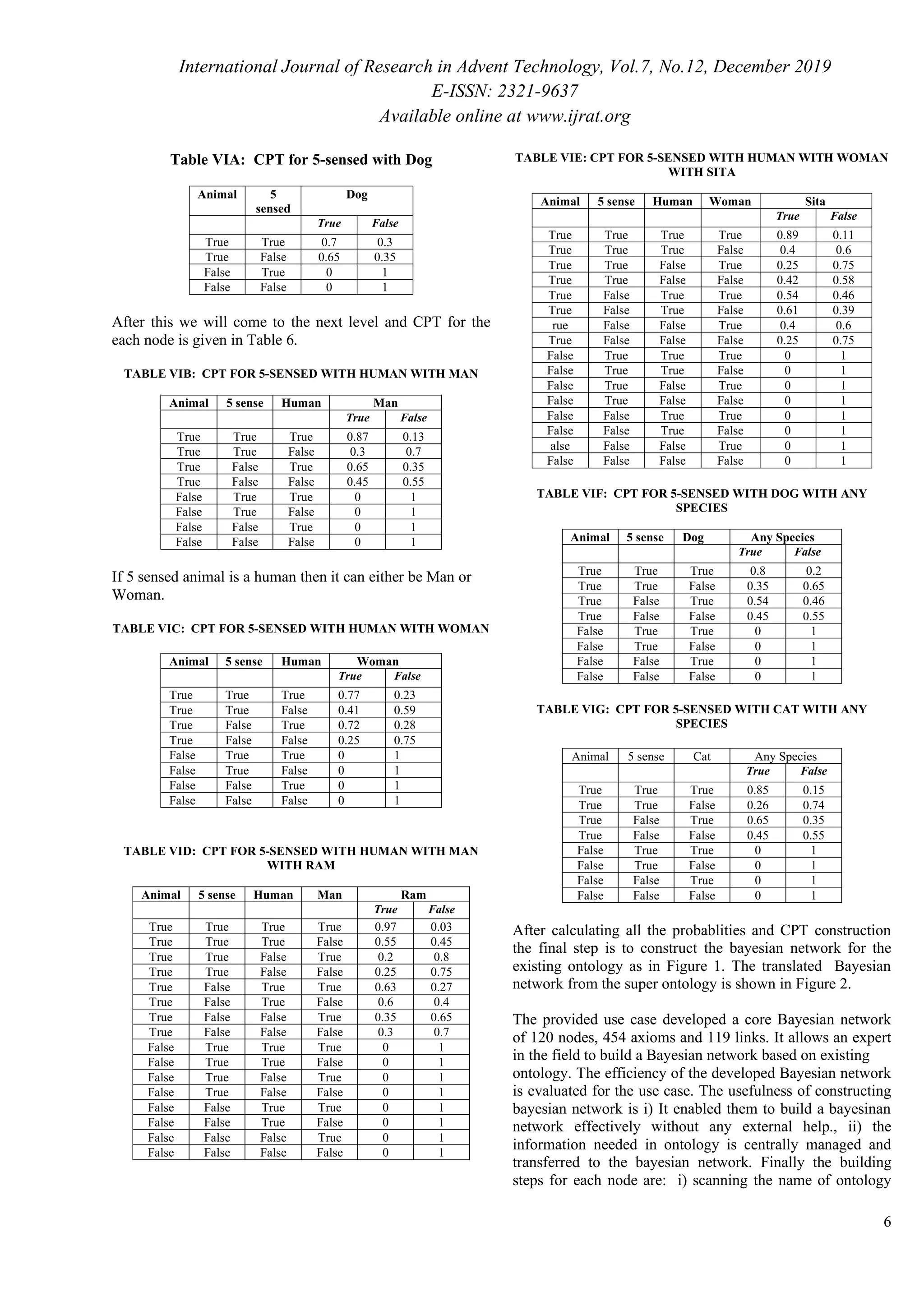This paper discusses the conversion of ontologies into Bayesian networks, highlighting the importance of dealing with uncertainty in semantic web contexts. It outlines a structured approach for constructing Bayesian networks from ontological concepts, including the identification of relevant nodes, the establishment of relationships, and the calculation of conditional probability tables (CPTs). The study also emphasizes the advantages of Bayesian networks in capturing interdependencies and managing uncertainty in complex systems.

![International Journal of Research in Advent Technology, Vol.7, No.12, December 2019
E-ISSN: 2321-9637
Available online at www.ijrat.org
2
eliminates redundant arcs and state spaces. The approach
does not help visual form quantification (i.e. tables with the
conditional probability). Ding et al (Ding, 2004) suggest
probabilistic OWL mark-ups which can be applied in the
OWL ontology to individual’s classes and properties. The
authors described a sequence of rules to translate the OWL
ontology into DAG. CPT’s for the each network node are
built on the logical properties of its parent node. The
approach presented in this article contrasts with the existing
approaches:
• The graphic Bayesian Network Structure needs no special
extensions
• It is a common technique and a model for constructing
Bayesian networks on the basis of current OWL ontology.
• The necessary ontological extensions have no influence on
existing classes and ontological individuals.
III. BAYESIAN NETWORK
A Bayesian network of n parameters comprises of a direct
acyclic graph, which has n nodes and set of arcs as a whole.
Xi nodes equate to variables in a DAG, and direct arcs
between two nodes indicate a direct causal relationship
between one node and the other. The uncertainty of this
relationship is localized by CPT P (Xi | Пi) for each node Xi
where Пi is the parent set of Xi. At least in theory, BN
accepts some assumption in the mutual probability
distribution. Although the probabilistic inference with the
general structure of DAG has been shown to be NP-hard
(Cooper, 1990), BN inferential algorithms including belief
propagation (Pearl, 1986) and junction tree (Lauritzen,
1988) were developed for BN's causal structures for
successful calculation.
It is helpful to add some simple mathematical notation for
parameters and distributions of probabilities. The parameters
are shown with upper case letters (A, B, C) and lower case
letters (a, b, c) for their meanings. If A = a, they say A was
instantiated. The bold upper-cases letter (X) is a number of
variables and the bold lower-cases letter (x) is a specific set
of variables. If, for example, X indicates A, B, C then x is
the instantiation a, b, c. |X| is denoted as number of variables
in X. |A| is denoted as the number of possible states of a
discrete variable A. The parent of X in a graph is referred by
P(X). P (A) is used to denote the probability of A.
For the joint probability denotation P (A, B) and P (A|B) is
used and for conditional probability for the given variables
A & B. For e.g, if A is unambiguous, then P (A) may be
equal to states {0.2, 0.8} i.e. 20% chance of truth and 80%
chance of false. A joint probability means the likelihood of
the existence of more than one parameter, as A and B,
referred to as P (A, B).
An example of joint probability distribution for variables
Raining and Windy is shown below in Table 1. For example,
the probability of it being windy and not raining is 0.28.
Table I: Joint Probability Distribution Example
Raining Wind=False Wind=True
True 0.1 0.9
False 0.72 0.28
The conditional probability is the likelihood of a variable,
given by another parameter, called (A|B). For example, the
probability of Windy being True, given that Raining is true
might equal 50%.
P (Windy = True | Raining = True) = 50%.
The whole theory of Bayesian network is based on Bayes
theorem that permits us to define the conditional probability
of evidence observing the cause based on the evidence.
P [Cause | Evidence] = P [Evidence | Cause] · P [Cause] P
[Evidence]
Each Bayesian network node is separate from its non-
descendants, provided that the parents have been in the
node. As Bayesian network is a function of probability, we
can use total likelihood as the criterion of statistical
knowledge. The highest probability estimation is a process
that calculates values for model parameters. The parameter
values are calculated so that the probability of the system as
defined by the model is maximized.
The benefit of the Bayesian network is that it handles
uncertainty in a tactful way as compare to other approaches.
A. Ontology Based construction of Bayesian network
For the development of Bayesian networks, the current
ontological method includes four major phases 1) select the
involved classes, individuals and properties, 2) Bayesian
Network Structure creation 3) Conditional probability Table
Creation 4) Inclusion of existing information
A. Select the involved classes, Individuals and Properties:
Every ontology class is well-defined, but a domain expert
must select those classes, individuals and properties that are
important to the problem considered and should be
represented within the Bayesian networks, although they are
semantically clear. Classes, individuals and properties are
relevant in this context as they affect the state of the final
output nodes of the Bayesian network (Fenz, 2012). The
domain expert must ensure that no redundant edges in the
Bayesian network are produced by selecting relevant
classes, individuals and properties. E.g. if A is influenced by
B and B by C only the edges of B to A, C to B are permitted.
The additional edge of C to A should not be permitted.
The domain expert has to select three different
class/individual types, 1) Node Class/Individual which is](https://image.slidesharecdn.com/712201907-200228054037/75/712201907-2-2048.jpg)




![International Journal of Research in Advent Technology, Vol.7, No.12, December 2019
E-ISSN: 2321-9637
Available online at www.ijrat.org
7
node and its type ii) state space include the allocation of
numerical value (for example “true” or “false”) iii) verifying
each node should be connected to the current node iv)
Linking of each node to its parent and its child.
Fig. 2: Translated BN for Super Ontology
V. CONCLUSION & FUTURE WORK
While creating the Bayesian Networks the following
challenges are faced: i) What variables are required for any
issue? ii) How to link these variables to each other? iii)
What are the states of the determined variables? To
overcome such problems, an ontology based approach for
developing Bayesian networks is introduced and
demonstrate its applicability for existing ontology. The
proposed method enables the creation of Bayesian networks
by giving the probablity at each node, which can handle
uncertainty also.
The limitations of this method is: Ontology does not
provide the functionsfor computing the CPT’s, it must be
explicitly modeled.
REFERENCES
[1] Z. Ding and Y. Peng, “A Probabilistic Extension to Ontology
Language OWL,” Proc. 37th Hawaii Int’l Conf. System Sciences
(HICSS 04), IEEE CS Press, 2004.
[2] http://www.w3.org/2004/OWL
[3] R. Neapolitan. Learning Bayesian networks. Prentice Hall, 2003.
[4] W. Lam, F. Bacchus, “Learning Bayesian belief networks: an
approach based on the mdl principle”, Computational Intelligence, vol
10, 1994. 269–293.
[5] P. Larrafiaga, C. Kuijpers, R. Murga, Y. Yurramendi, “Learning
Bayesian network structures by searching for the best ordering with
genetic algorithms”, IEEE Transactions on Systems, Man, and
Cybernetics — Part A 26, 1996 487–493.
[6] N. Friedman, D. Koller, “Being Bayesian about network structure. a
Bayesian approach to structure discovery in Bayesian networks”,
Machine Learning 50, 2003, 95–125.
[7] E.R.H. Jr., N.F. Ebecken, “Towards efficient variables ordering for
Bayesian networks classifier”, Data & Knowledge Engineering, vol
63 (2), 2007 258–269.
[8] E.M. Helsper, L.C. van der Gaag, Building Bayesian networks
through ontologies, in: F. van Harmelen (Ed.), ECAI 2002:
Proceedings of the 15th European Conference on Artificial
Intelligence, IOS Press, 2002, pp. 680–684.
[9] G. F. Cooper, “The computational complexity of probabilistic
inference using Bayesian belief network,” Artificial Intelligence, vol.
42, 1990, 393–405.
[10] J. Pearl, “Fusion, propagation and structuring in belief networks,”
Artificial Intelligence, vol. 29, 1986, 241–248.
[11] S. L. Lauritzen and D. J. Spiegelhalter, “Local computation with
a. Probabilities in graphic structures and their applications in expert
systems,” J. Royal Statistical Soc. Series B, vol. 50(2), 1988, 157–
224.
[12] S. Fenz. “An ontology-based approach for constructing Bayesian
networks”, Data & Knowledge Engineering, volume 73, 2012, 73–88.
[13] S. Zhang, Y. Sun, Y. Peng, X. Wang, BayesOWL: A Prototypes
System for Uncertainty in Semantic Web. In Proceedings of IC-AI,
678-684, 2009.
[14] S. Malik, S. Jain, “Sup_Ont:An upper ontology (Accepted for
Publication),” IJWLTT, IGI Global, to be published.
[15] http://www.umich.edu/~umjains/jainismsimplified/chapter03.html.
[16] http://www.jainlbrary.org/JAB/11_JAB_2015_Manual_Finpdf.
AUTHORS PROFILE
Sonika Malik has done B.Tech from Kurukshetra
University, India in 2004 and did her Masters from
MMU in 2010. She is doing her doctorate from
National Institute of technology, Kurukshetra. She
has served in the field of education from last 12 years
and is currently working at Maharaja Surajmal
Institute of Technology, Delhi. Her current research
interests are in the area of Sematic Web, Knowledge
representation and Ontology Design.](https://image.slidesharecdn.com/712201907-200228054037/75/712201907-7-2048.jpg)